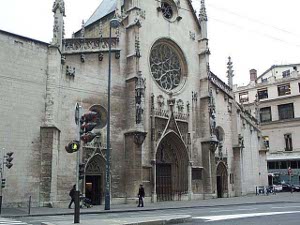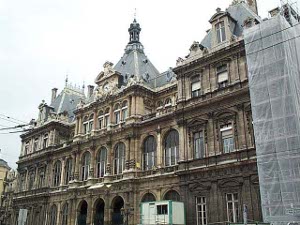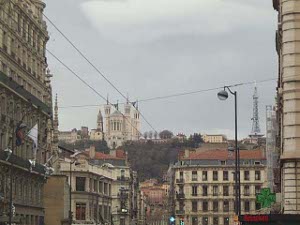 Saint Bonaventure Church
Saint Bonaventure Church
Yesterday we saw a bronze statue of Louis XIV astride a horse in Place Bellecour. We didn't understand why it was inscribed Chef d'Oeuvre of the Sculptor -- the principal creation of his artistic life. It looked like boasting. Today we learned the reason. The first statue was destroyed by mobs during the French Revolution but when order was restored a new statue was erected. However, in 1848 another rebellious mob almost tore down the new one. It was only saved when one of the city fathers suggested that it was really an art work, not primarily a statue of royalty, and so it is now a monument supposedly in honor of a now-forgotten sculptor.
 Saint Bonaventure Church
Saint Bonaventure Church
Today we left the hotel and walked west, toward the rivers. Through the buildings we keep catching glimpses of Notre Dame de Fourviere, which dominates the city.
We stopped to see Saint Bonaventure, a large fourteenth-century church with lovely stained glass windows. Across the street was the old Bourse.
We had read about the wonderful gastronomic delicacies for sale in Lyons -- pates in aspic and stuffed snails and the like -- and were anxious to see the markets. The lady at the Tourist Information Office directed us to a lovely market set up in stalls along the Saone; it was full of fruits and vegetables, flowers and meats and fish, but not the prepared foods we had been expecting. So we need to keep looking.
While we walked along the Saone, we saw an interesting bridge. It was a suspension bridge with only one tower, whose taut cables supported the bridge  The Bourse
all the way across. We later found the reason for this design; the city fathers did not want the other tower to spoil the view of the beautiful buildings in Old Lyons across the river!
The Bourse
all the way across. We later found the reason for this design; the city fathers did not want the other tower to spoil the view of the beautiful buildings in Old Lyons across the river!
With all the rain we've been having, the rivers are very high and turbulent. As we crossed the pedestrian bridge to the old city we noticed the water lapping over the walkway and into the lowest level of the parking garages.
We found ourselves walking through the narrow twisty streets which are characteristic of the old parts of European cities. There were tour groups checking out the architecture, and we followed one of them into a courtyard with a spiral staircase winding up inside a circular pink stucco tower. We have decided that tour groups are a year-round phenomenon in Europe, and the advantage of traveling off-season is just that there are a lot less of them! A few blocks further on we found a dog water fountain; when you push the button on the side, water fills the bowl for the dog to drink.
But the old city is a shabby neighborhood. Graffiti covers the walls,  Salted Icelandic cod
streets are dirty, shops display cheaper goods and there are more vacant buildings than in the more modern areas of the city. Nevertheless the old city is also home to musicians, artists and young families who provide color and spirit.
Salted Icelandic cod
streets are dirty, shops display cheaper goods and there are more vacant buildings than in the more modern areas of the city. Nevertheless the old city is also home to musicians, artists and young families who provide color and spirit.
We crossed the Saone again, leaving the old quarter. We soon reached the Place des Terreaux with its wonderful huge horsy fountain. The entire square has been fitted with little water jets, which were sending water shooting up into the air as people crossed between them. Here was the ornate facade of the city hall, and here was the entrance to the Beaux Arts Museum.
We started at the top floor, and were somewhat distracted by a large cylindrical stone and stucco structure which filled most of one room. Walled off from the rest of the gallery, it is just there. Originally this part of the gallery didn't have windows, so this tower, which is roughly the diameter of a small lighthouse, was built as a lantern, to supply light somehow for the staircase then in use. But the reconstruction of the museum added windows, so  Fruit for sale
they didn't need the lantern.
Fruit for sale
they didn't need the lantern.
But they didn't want to take it down because, apparently, nobody is really sure if that is its only purpose. It's an architectural curiosity.
The paintings are arranged by nationality and time period, and it was not until we got to nineteenth-century French painting that we really got enthusiastic. There were six or seven galleries from this period, and we oohed and ahhed over works from Corot to Chagall.
We had lunch in the museum cafeteria, and then moved on to the Museum of the Resistance and Deportation.
Lyons was a center of the Resistance during the Second World War because of its location close to the Swiss border, its political traditions, and the presence of Jean Moulin, the coordinator of most of the French Resistance groups. Many groups in Lyons helped Jews and other threatened people to escape occupied France.
We have visited many resistance museums in western Europe, and we are interested in how the subject is covered. In fact, resistance activities always started off slowly and then increased in intensity as the German military rule grew harsher and the Allied military strength grew stronger. In most countries,  Vegetables for sale
the biggest surge in resistance activities was in 1944-45, as the Allied victory was imminent. But in the beginning, there were many people, in all countries, who were pro-Nazi and thought the Germans would be victorious. A key point of interest to us is how many non-German civilians participated actively in the holocaust.
Vegetables for sale
the biggest surge in resistance activities was in 1944-45, as the Allied victory was imminent. But in the beginning, there were many people, in all countries, who were pro-Nazi and thought the Germans would be victorious. A key point of interest to us is how many non-German civilians participated actively in the holocaust.
We have already commented on the dismal Resistance museum in Paris --a small and shabby array of papers and tiny old photos and lots of praise of DeGaulle. So we were very pleased to see the much more accurate treatment of the subject in Lyons.
This museum is housed in the very building where the victims were detained, interrogated, tortured, and deported or killed. The current exhibits were completed in 1994, taking full advantage of photography, video, and other display techniques, and providing a most moving and thoughtful experience. Major captions were in French and English, and we were provided with headsets which provided translations of the video displays into English, as well as several other languages. This was invaluable, as the videos were very good, featuring old film footage and interviews with those who survived the war.
Walking through a dark winding path with exhibits on both sides, we learned about life under the Vichy government of Petain and some of the struggles of the French to survive those awful years. Of course, a museum experience cannot fully answer all the questions which arise, but a good museum, like this one, helps pose questions for further study.
 Notre Dame de Fourviere
Notre Dame de Fourviere
At the very beginning of the museum there was a video introduction in which a French university professor said the works of Columbia University historian Robert Paxton on the subject of Vichy France had stirred great debate in France and caused the museum to be completely revised in light of his findings. We hope to read Paxton's work on our return to the U.S.
The museum displays indicate that 75% of French Jews survived the deportations, but it does not tell how many of these were hidden or escaped the country. Of the 25% who were deported, only 3% survived.
In comparison with other similar museums, this Lyons museum paints a dramatic picture of the horrors of the German occupation and Jewish persecution, the complicity of some of the Vichy collaborators, and the bravery and good deeds of the Resistance fighters. But it is a little light on quantitative information: how many French people collaborated, how many resisted, how many were neutral, year by year as the war progressed? It may be that this information is not known to any accuracy, but it is quite important for understanding the mistakes of the past.
The two museums which we visited today could hardly have been more different, yet both help us to think about what it is to be French today, living in a city with a prosperous present, a promising future, a rich artistic heritage, and a history of both horrible hatred and heroic resistance to injustice within the memories of living persons.
On the way back to the hotel, we watched the city workers cleaning up the produce market debris, just as efficiently as they had in Toulouse.